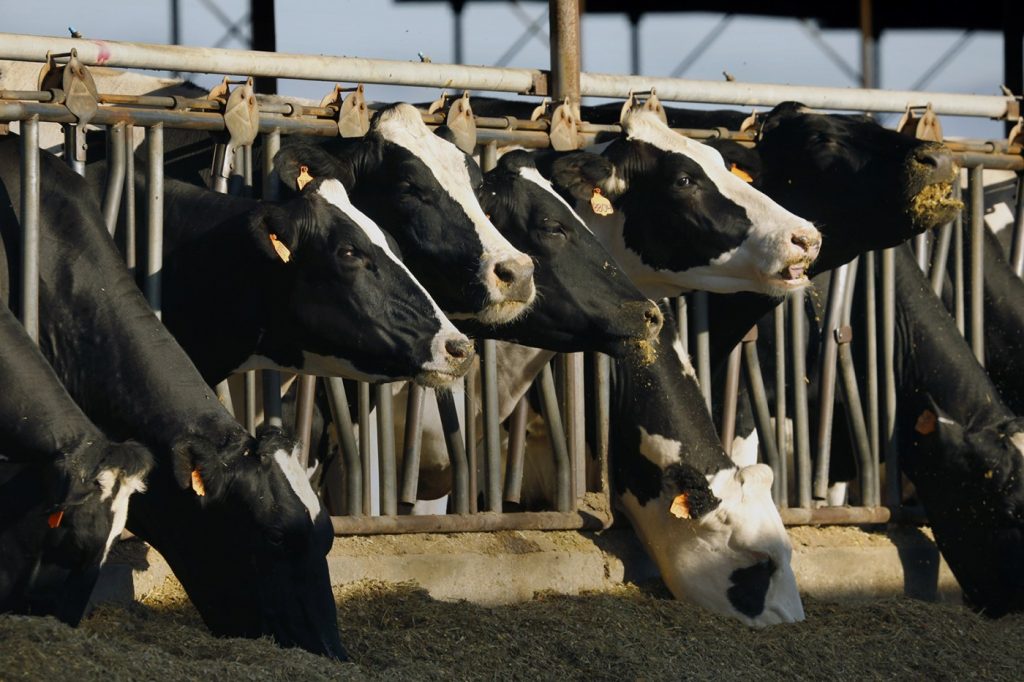Susanne Rust | (TNS) Los Angeles Times
Despite assurances from the federal government that bird flu will be eradicated from the nation’s dairy cows, some experts worry the disease is here to stay.
Recently, Eric Deeble, USDA acting senior advisor for H5N1 response, said that the federal government hoped to “eliminate the disease from the dairy herd” without requiring vaccines.
Since the disease was first publicly identified in dairy cattle on March 25, there have been 129 reports of infected herds across 12 states. In the last four weeks, there has been a surge — jumping from 68 confirmed cases on May 28 to nearly twice that many as of June 25. There are no cases in California.
So far, however, the dairy industry has proved reluctant to work with state and federal governments to allow for widespread testing of herds.
To some epidemiologists, this lack of close herd surveillance is a problem. They worry that the virus is spreading unchecked among dairy cows and other animals, and has taken up permanent residence.
David Topham, a professor of microbiology and immunology at the University of Rochester’s Center for Vaccine Biology and Immunology, said he considers H5N1 to be “endemic in animals in North America” — citing its prevalence in wild bird populations as well as its long staying power in domestic poultry.
No one knows how widespread it is in cattle, Topham said, because testing has largely targeted symptomatic cows and herds. “But I suspect the closer we look, the more we’ll find, and I don’t know if we’re going to cull our entire cattle herds and start over again.”
Topham said he understands the industry’s reluctance to permit government scientists onto farms “because we’re going to want to see everything, and we’re going to report everything that we see, and that might be bad for business. … But until we have all that information, I don’t think we will have control.”
Federal officials have announced a pilot bulk milk testing program that includes Kansas, Nebraska, New Mexico and Texas. Farmers in these states can voluntarily enroll to have bulk milk samples tested for the virus. If their samples test negative for three weeks, they will be able to move their herds across state lines without additional testing — something they are currently unable to do.
So far, only one herd in each state has signed up.
A USDA “strike force” investigated 15 infected Michigan dairy herds as well as eight turkey flocks in early April. It worked with the state of Michigan as well as individual farmers.
The investigation was launched after local researchers identified a “spillover” event that went from infected cattle to a nearby poultry plant. The state — and farmers — wanted to know how it happened.
What the team found suggests the “control” Topham referred to may be elusive.
From surveys and observations, they found that cats and chickens were free to walk around without containment — potentially migrating between nearby dairies and poultry farms. Some of these animals had become infected; several died.
Asked about their practices regarding isolation of newly introduced cattle, three out of 14 farms said they always isolated, another three said they never isolated, and the remainder didn’t respond.
Then there was the dumping of unpasteurized, contaminated milk into the open waste lagoons on several of the farms. And the feeding of non-pasteurized milk to calves on three farms. Or the potentially contaminated manure that was stored, composted or applied to nearby fields. In one case, a farmer reported they had sold or given away potentially contaminated manure.
Finally there was the issue of humans: On every farm, there were visitors, carcass removal companies, milk suppliers, veterinarians and employees — many of whom traveled between farms.
For instance, of the 14 dairies that reported information about their employees, three had employees that worked at other dairies, one had employees that worked at a poultry farm, and one had an employee who also worked at a swine farm. At four dairies, some of the employees were reported to have their own livestock at home.
As the authors reported, “transmission between farms is likely due to indirect epidemiological links related to normal business operations … with many of these indirect links shared between premises.”
They noted there was no evidence to suggest waterfowl had introduced the virus to the Michigan herds.
Michael Payne, researcher and outreach coordinator at UC Davis’ School of Veterinary Medicine Western Institute for Food Safety and Security, said there was no one to blame for the lack of containment.
He said in the weeks and months before the disease was identified in cattle, researchers from across the nation scrambled to figure out what was happening to dairy cows in Texas that appeared listless and had diminished milk production.
“It’s not like people weren’t aware or concerned and trying to figure it out,” he said. And then once it was identified, and it didn’t seem to cause too much illness in cows or transfer to humans quickly, while there was urgency, the system fell into a series of “incremental” solutions — negotiated among dozens of federal and state agencies.
He and Topham agree that no one can say for sure what the virus will do — and where it will go — next.
If it becomes endemic in cattle and is renamed “bovine influenza,” vaccines are likely to follow, as well as continuous surveillance and testing of dairy products.
Topham said that the biggest concern among epidemiologists now is how the virus will evolve as it continues to move — largely unabated and undetected — through cattle herds, resident farm animals and people.
There have been three human cases of H5N1 in U.S. dairy workers since March.
One key worry is that the virus may move with a dairy employee onto a small farm and then recombine inside a pig, dog or cat that is harboring another flu virus.
He and Payne agree that officials need to remain alert to signs that the virus is adapting in ways that could hurt humans.
Wastewater is one way to detect the location of the virus.
As of Tuesday, data from the academic research organization WastewaterSCAN show that levels of H5 influenza have been rising in wastewater samples from a facility in Boise, Idaho.
Asked about whether the region’s health department was investigating, or if there was any idea where the H5 was coming from, Surabhi Malesha, communicable disease program manager at Central District Health in Idaho, said there was no way to know if the H5 signal was from H5N1 or another influenza subtype.
Related Articles
CDC has 1 million bird flu tests ready, but experts see repeat of COVID missteps
Bird flu tests are hard to get. So how will we know when to sound the pandemic alarm?
Oprah Winfrey hospitalized for ‘serious stomach thing’; reps say it’s the flu
Another COVID vaccine? Yes, and here’s why
Death of Mexican man linked to bird flu strain that’s new in humans
She said testing for H5 in wastewater had only recently started and therefore “there is no way to compare this data from last year or the year before, and so we don’t know what a baseline detection of H5 looks like.”
“Maybe we see H5 detections like this on a regular basis, and it is not of public health significance or importance. … How do we define normalcy when we have nothing to compare the data to?”
She said the findings were “not a public health concern” and her agency and the state “do not need to really investigate into this, because this could be H5N1, or could be any other H5 strains, and it really does not affect the public in general.”
Dennis Nash, distinguished professor of epidemiology and executive director of City University of New York’s Institute for Implementation Science in Population Health, said that given the current situation, the wastewater sample should be considered H5N1 “until proven otherwise. The only other H5 we know about is H5N2. And a man in Mexico City just died from that.”
Nash said health officials should be trying to determine the source of the virus found in the wastewater: a nearby dairy herd, a milk processing site or raw milk that was dumped down the drain.
Idaho has reported 27 infected herds, although according to Malesha, none has been reported in the Central District.
“You want to do everything you can to prevent these types of viruses from emerging, because once they do, we don’t have a whole lot of control over them,” Topham said. “Because when the horse is out of the barn, it’s gone. So I think the question is, what do we need to do to keep this in check?”
©2024 Los Angeles Times. Visit at latimes.com. Distributed by Tribune Content Agency, LLC.


